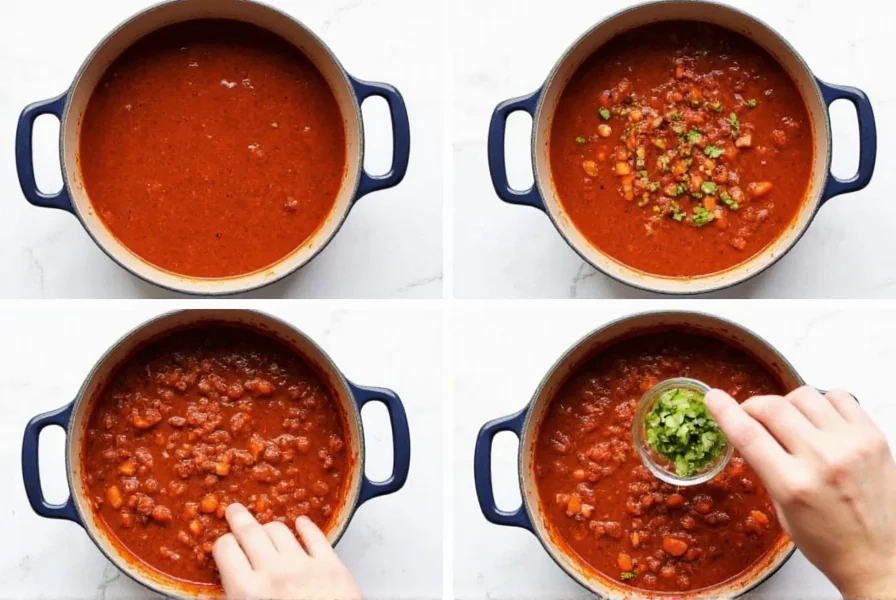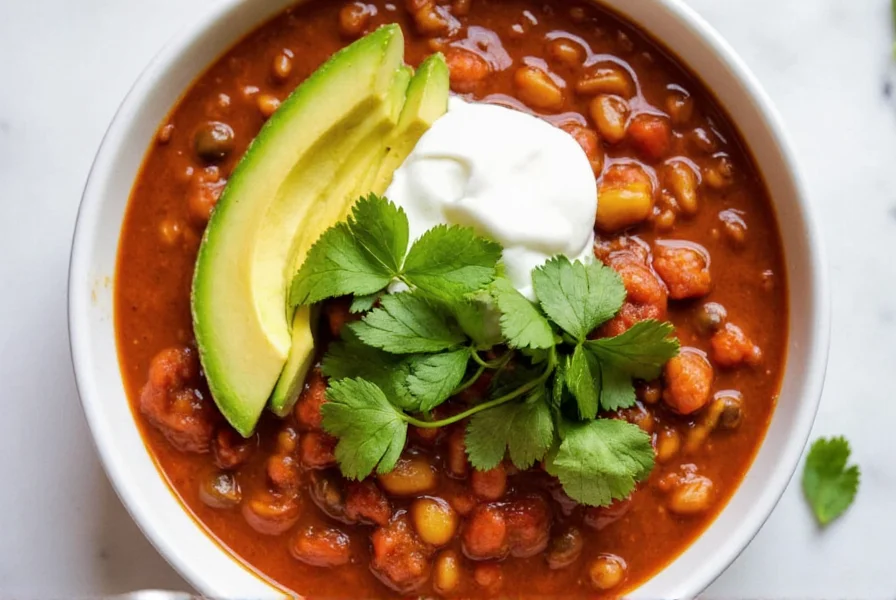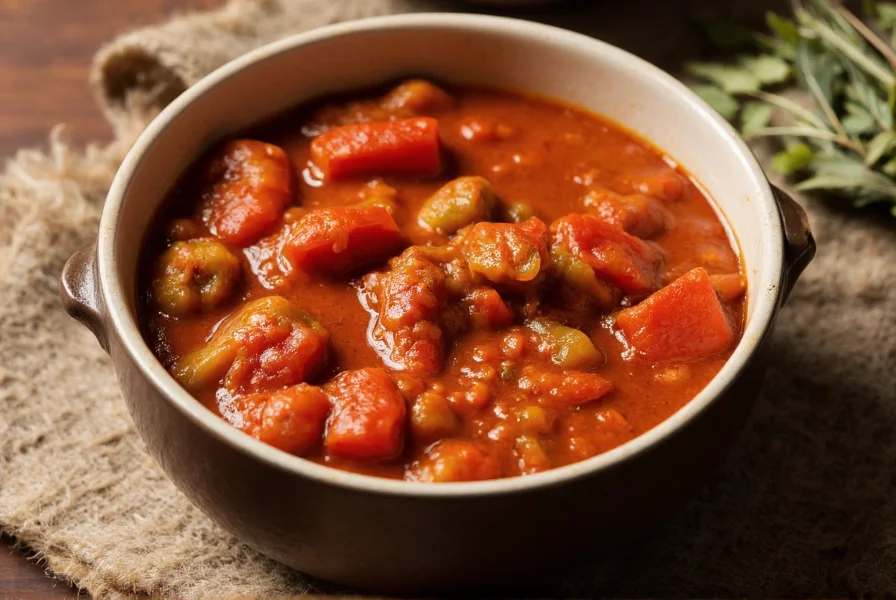Vegetarian chili has become a staple in healthy eating for good reason. This robust dish satisfies cravings while delivering substantial nutritional benefits. Whether you're a committed vegetarian, reducing meat consumption, or simply seeking a flavorful weeknight dinner, understanding how to create the perfect vegetarian chili is essential.
What Makes Vegetarian Chili Different From Traditional Chili?
While traditional chili relies on ground beef or other meats as its protein foundation, vegetarian chili substitutes these with plant-based proteins. The best vegetarian chili recipes maintain the complex flavor profile through strategic use of spices, umami-rich ingredients, and proper layering of flavors. Key differences include:
- Protein sources: Beans (kidney, black, pinto), lentils, textured vegetable protein (TVP), or plant-based meat alternatives
- Flavor depth: Achieved through smoked paprika, chipotle peppers, and vegetable broth instead of meat drippings
- Nutritional profile: Higher fiber content and lower saturated fat while maintaining comparable protein levels

Essential Ingredients for Perfect Vegetarian Chili
Creating exceptional vegetarian chili requires understanding which ingredients contribute specific elements to the final dish. Here's what you need to know about each component:
| Ingredient Category | Key Components | Function in Chili |
|---|---|---|
| Beans & Legumes | Kidney beans, black beans, pinto beans, lentils | Protein foundation and texture |
| Aromatics | Onion, garlic, bell peppers | Flavor base and complexity |
| Tomato Base | Crushed tomatoes, tomato paste | Acidity and body |
| Spices | Chili powder, cumin, smoked paprika | Signature flavor profile |
| Umami Boosters | Mushrooms, soy sauce, liquid smoke | Meaty depth without meat |
Step-by-Step Vegetarian Chili Recipe
Follow this method for restaurant-quality vegetarian chili at home. This easy vegetarian chili recipe for beginners yields six generous servings.
Ingredients You'll Need
- 2 tablespoons olive oil
- 1 large yellow onion, diced
- 3 cloves garlic, minced
- 1 red bell pepper, diced
- 1 green bell pepper, diced
- 2 medium carrots, finely chopped
- 1 cup mushrooms, finely chopped (for umami)
- 3 tablespoons chili powder
- 2 teaspoons ground cumin
- 1 teaspoon smoked paprika
- 1/2 teaspoon cayenne pepper (optional)
- 2 (15-ounce) cans kidney beans, drained and rinsed
- 1 (15-ounce) can black beans, drained and rinsed
- 1 (28-ounce) can crushed tomatoes
- 1 (6-ounce) can tomato paste
- 2 cups vegetable broth
- 1 cup frozen corn
- Salt and freshly ground black pepper to taste
Preparation Method
- Sauté vegetables: Heat olive oil in a large pot over medium heat. Add onions and cook until translucent (about 5 minutes). Add garlic, bell peppers, carrots, and mushrooms. Cook for 8-10 minutes until vegetables soften.
- Bloom spices: Stir in chili powder, cumin, smoked paprika, and cayenne. Cook for 1-2 minutes to release essential oils and deepen flavors.
- Add liquids: Mix in tomato paste, crushed tomatoes, and vegetable broth. Bring to a gentle simmer.
- Incorporate beans: Add kidney beans, black beans, and corn. Stir well to combine.
- Simmer: Reduce heat to low, cover, and simmer for 45-60 minutes, stirring occasionally. The longer it simmers, the more flavors meld together.
- Season: Taste and adjust salt, pepper, and spices as needed before serving.

Customizing Your Vegetarian Chili
One of the best aspects of vegetarian chili recipes for meal prep is their adaptability. Consider these variations based on dietary needs and preferences:
- Gluten-free: Naturally gluten-free when using certified vegetable broth
- Vegan: Ensure no dairy toppings; use coconut yogurt instead of sour cream
- High-protein: Add 1 cup cooked quinoa or 1/2 cup textured vegetable protein
- Spiciness levels: Adjust cayenne pepper or add diced jalapeños for heat
- Bean variations: Try cannellini beans, chickpeas, or adzuki beans for different textures
Serving Suggestions for Maximum Enjoyment
The perfect vegetarian chili serving ideas transform this humble dish into a complete meal experience. Consider these pairings:
- Classic toppings: Avocado slices, sour cream or Greek yogurt, shredded cheese, fresh cilantro, lime wedges
- Side dishes: Cornbread, rice, or a simple green salad
- Meal integration: Use as a filling for baked potatoes or as a topping for nachos
- Creative twists: Serve over baked sweet potatoes or use as a taco filling
Storage and Reheating Tips
Vegetarian chili actually improves in flavor after sitting, making it ideal for vegetarian meal prep chili recipes. Follow these storage guidelines:
- Refrigeration: Store in airtight containers for up to 5 days
- Freezing: Portion into freezer-safe containers for up to 3 months
- Reheating: Warm on stove over medium-low heat, adding a splash of broth if needed
- Flavor boost: Add fresh lime juice and cilantro after reheating for bright flavor
Common Mistakes to Avoid When Making Vegetarian Chili
Even experienced cooks can make errors with vegetarian chili from scratch. Watch out for these pitfalls:
- Rushing the spice blooming: Skipping the step of cooking spices in oil reduces flavor complexity
- Overcooking vegetables: Adding delicate vegetables too early makes them mushy
- Insufficient seasoning: Vegetarian dishes often need more salt than meat-based counterparts
- Skipping the resting period: Allowing chili to sit for 15-30 minutes before serving improves flavor integration
- Using low-quality broth: The broth forms the flavor foundation—choose a robust vegetable variety
Nutritional Benefits of Vegetarian Chili
Beyond its delicious taste, healthy vegetarian chili nutrition facts make it a nutritional powerhouse. A typical serving provides:
- Protein: 15-20 grams from beans and legumes
- Fiber: 10-15 grams, supporting digestive health
- Vitamins: Rich in vitamin C from bell peppers and tomatoes
- Minerals: Excellent source of iron, magnesium, and potassium
- Antioxidants: High levels from tomatoes, peppers, and spices
Regular consumption of bean-based dishes like vegetarian chili has been linked to improved heart health, better blood sugar control, and reduced inflammation according to nutritional research.











 浙公网安备
33010002000092号
浙公网安备
33010002000092号 浙B2-20120091-4
浙B2-20120091-4